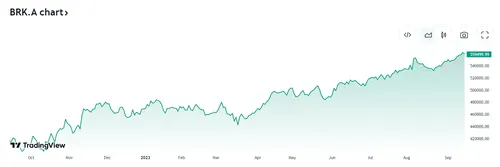Our partner, XM, lets you access a free demo account to apply your knowledge.
No hidden costs, no tricks.

It is no secret that stock prices are dependent on supply and demand. The higher the demand, the higher the price of the stock, all things being equal.
However, why certain stocks have abnormally high or low prices can be difficult to measure for beginner traders.
For example, certain stocks may sell for less than a dollar, while others, such as Warren Buffett’s Berkshire Hathaway (BRK.A) is notorious for being the most expensive stock on the market at over $561,000 per share.
Aside from supply and demand, other factors, such as total shareholder’s equity, overall financial health, stock buybacks and more can affect the exact pricing of a stock.
However, with the advent of fractional share trading, this has become a non-issue for most traders, as they can buy a 1/100th of a Berkshire Hathaway share at over $5,600, which, while not cheap, is still considerably more affordable than the full share price.
If you are a beginner trader and would like to delve deeper into stock pricing, this Investfox guide can help you.

Stock prices are constantly changing. These changes are directly dictated by the market via supply and demand. The process is simple - when the issuing company is performing well and investors are excited about its future prospects, they buy more and the price of a single share increases. When the market is pessimistic, investors sell and the price drops.
However, what factors play into the initial pricing of a company’s shares and why there is so much discrepancy between stocks from different industries is a different story altogether.
Whether it is a startup that had its IPO months ago, or a well-established component of the S&P 500, the key reasons behind stock prices are largely the same. We can review some of them below.
The size of a company, as well as its market capitalization have a direct impact on the price of a singular share. As the formula for market capitalization is:
Market Capitalization = Total Outstanding Shares X Price Per Share
This means that both market capitalization and share price are dependent on the total number of outstanding shares. Companies can adjust this number via share redemptions, buybacks, stock splits, etc.
When a company buys its own shares from the market, these are called treasury shares and are excluded from the free float, meaning traders cannot buy and sell them anymore.
Companies usually buy their own shares to limit the supply and artificially boost the share price.
Companies can choose to split their stock to adjust the stock price. In a stock split, the company increases the number of outstanding shares, which typically leads to a lower stock price per share.
For example, in a 2-for-1 stock split, each shareholder receives two shares for every one they previously held, effectively halving the stock price.
Conversely, a reverse stock split reduces the number of outstanding shares and increases the stock price per share.
Reverse splits are typically done when stock prices drop too low and trading them becomes unaffordable for retail traders due to high per share commissions.
Stock prices also vary between industries. For example, tech stocks generally tend to have higher stock prices than those from older, more traditional industries, such as manufacturing.
This is largely due to the fact that stocks that have been public for decades historically did not have the benefit of fractional share trading and tried to keep their stock prices as low and affordable to retail investors as they could.
Furthermore, larger companies tend to go through multiple stock splits, which is why their stock prices tend to be lower than newer players on the market.
Thanks to the advent of fractional share trading, contemporary companies do not have to worry about their price per share and can focus on the performance of their stock.
Fractional shares have become more and more popular, to the point that they are now considered the norm and brokerages that do not offer fractional share ownership are considered to be lagging behind.
Therefore, while the prices of individual shares were important in the past, they are practically a non-factor in contemporary trading, due to more convenient offerings from stock brokers.
Our partner, XM, lets you access a free demo account to apply your knowledge.
No hidden costs, no tricks.
Certain stocks are highly expensive thanks to their reluctance to issue more shares, which limits the total outstanding shares without dwindling the demand for said shares, thus increasing the price.
Stocks are priced using the principles of supply and demand, where the dynamics between the demand on the market and the total supply of tradable shares determine the price per share.
When a stock split happens, the number of outstanding shares is multiplied by the split factor. Typically, companies undergo a 2:1 or 3:1 stock split. This is to reduce the price per share for the stock, making it more affordable for retail investors.